FC UTA Arad
 | ||||
| Full name | Fotbal Club UTA Arad | |||
|---|---|---|---|---|
| Nickname(s) |
| |||
| Short name | UTA | |||
| Founded |
| |||
| Ground | Motorul | |||
| Capacity | 4,000 | |||
| Owner | UTA Supporters Association | |||
| Chairman | Florian Voinea | |||
| Manager | Ionuț Popa | |||
| League | Liga II | |||
| 2017–18 | Liga II, 12th | |||
| Website | Club website | |||
|
| ||||
Fotbal Club UTA Arad (Romanian pronunciation: [ˈuta aˈrad]), commonly known as UTA Arad, or simply as UTA, is a Romanian professional football club based in the city of Arad, Arad County, currently playing in Liga II. UTA stands for Uzina Textilă Arad.
Founded in 1945 as IT Arad, they have won the national title six times and the national cup twice. Domestically, along with Chinezul Timișoara, UTA can be considered one of the most successful Romanian clubs of the 20th century, with only three teams winning more championships during that period, Steaua, Dinamo and Venus, all from Bucharest.
After a decline which started in 1979 with a relegation to the second league, in 2014 the team was dissolved.[1] With the support of fans, a new team started its way back from Liga IV, the fourth level of Romanian league system, and is credited as the official successor of the defunct club.[2]
"The Old Lady" plays in red and white kits at the Motorul Stadium, as their traditional home ground, Francisc von Neuman, is currently under reconstruction.
History
Establishment and first success (1945–1965)
The old lady was founded by the baron Francisc von Neuman, the owner of the Arad Textile Company, on April 18, 1945. The colors of the club (white - red) were inspired by Arsenal's colors, Neuman being a great fan of this team.[3]
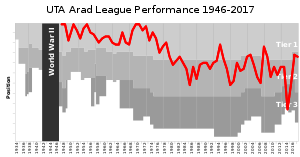
It was here, on the corner, where the UTA platform is. Where the stadium is today, across the street. He held a meeting, there were many of his friends, engineers, trusted people. He said he wants to make a football team, who has a name to propose? Someone said Gloria, who was gone, someone else proposed to be like the factory: ITA. It was their factory! Good. And what colors should the team have? After many discussions it was noted to be white with green. Nobody knows today that for a few minutes, UTA had these colors: white-green. Then the baron, who had in mind the red-white combination of Arsenal, but he was so delicate he did not want to impose anything, was saved by someone from the community who said he could not "white with green, because are Nazi colors." People woke up and the colors remained white and red like on Highbury. Like Highbury was going to be the stadium, just a little smaller. (Dionisie Piros)[4]
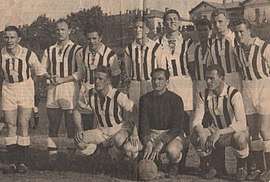
The first football match of the newly established team was on 27 May 1945 against Banatul Sânnicolau Mic, score 2-3. The composition of the first team was: Tudor, Bocşa, Tamaş, Lingurar, Dvorszak, Szurdi, Găluţ, Mărienuț, Haller, Cosnita, Brosovszky. Coaches: Francis Dvorszak, Joszef Szallay and Gheorghe Albu.
On 1 September 1946 on the occasion of the match between ITA and Ciocanul București, score 1-0, took place the inauguration of the stadium in Arad, Francisc von Neuman Stadium. At that time it was considered the most beautiful stadium in the country.[5]
| Name | Period |
| ITA Arad | 1945–1949 |
| Flamura Roșie Arad | 1950–1957 |
| UTA Arad | 1958–2014 |
| UTA Bătrâna Doamnă Arad | 2014–2017 |
| UTA Arad | 2017–present |
The club enters in the National Football Championship, in the 1946–47 edition, bearing the name ITA., the initials of the company. The first participation, in the first league, bring the first title of champion, with a difference of 11 points ahead of the second place, occupied by the Carmen București. The composition of the first championship team was: Alexandru Marky, Gyula Lóránt, Gheorghe Băcuţ, Adalbert Pall, Alexandru Meszaros, József Pecsovszky, Adalbert Kovacs, Ioan Reinhardt, Andrei Mercea, Ladislau Bonyhádi, Mátyás Tóth. Ladislau Bonyhádi becomes the goalscorer of the championship with 26 goals.
In the 1947–48 edition, ITA. won the second championship title, with an impressive goal difference of 129-21, record unbeaten until today and Ladislau Bonyhádi contributed with 49 goals, also an the all-time record.[6] In this edition the final of the Cupa României was against CFR Timișoara, also won with the score of 3-2. The winning team was: Alexandru Marky, Moise Vass, Zoltan Farmati, Gheorghe Băcuț, Adalbert Pall, József Pecsovszky, Adalbert Kovacs, Ioan Reinhardt, Ladislau Bonyhádi, Iosif Stibinger, Nicolae "Coco" Dumitrescu.
At the end of 1948–49 season, ITA was ranked only 9th.
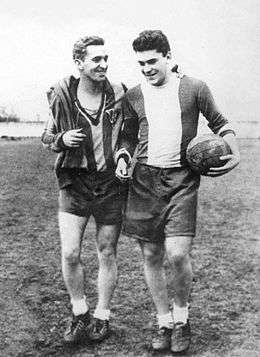
In the 1950 edition, under the name of Flamura Roșie, the club won a new title of champion. In the same year they qualified in the Cupa României final, but lost 1-3 in front of CCA București. The team used in the final of the cup was: Alexandru Marky, Moise Vass, Zoltan Farmati, Adalbert Pall, Ioan Reinhardt, Ladislau Baccu, Silviu Boitoş, Mihai Carpinet, József Pecsovszky, Andrei Mercea, Nicolae "Coco" Dumitrescu.
In 1951 the club was ranked 4th at the end of the competition.
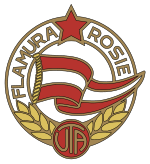
In 1952 the old lady occupied the 8th place, and in 1953 was on the third place and won a new edition of the Romanian Cup, against CCA București, score 1-0. The winning team was: Francisc Kiss, Gavril Szücs, József Kapás, Zoltan Farmati, Mihai Carpineţ, Gavril Serfözö, Nicolae Popa, Gheorghe Wencesla, Adalbert Kovacs, Andrei Mercea, Nicolae "Coco" Dumitrescu, Mircea Popovici, Gheorghe Lupeş. Coach: Coloman Braun-Bogdan.
In 1954, under the direction of the coach Braun-Bogdan, the white and reds won the fourth title of champion. The members of the team were: Francisc Kiss, Gavril Szücs, József Kapás, Dusan, Zoltan Farmati, Gavril Serfözö, Birău, Gheorghe Váczi, Ilie Don, Andrei Mercea, Nicolae "Coco" Dumitrescu.
In 1955 Flamura Roșie occupied the 5th place at the end of the competition, in 1956 they finished on the 6th place, and at the end of the 1957–58 edition the club finished on 10th place.
In 1958 the club changed its name from Flamura Roșie to UTA. (Arad Textile Factory).
In the following years UTA occupied the following positions at the end of the championship: 1958–59 – 8th, 1959–60 and 1960–61 – 7th, 1961–62 – 10th, 1962–63 and 1963–64 – 11th, 1964–65 – 5th.
The second Golden Generation (1965–1975)
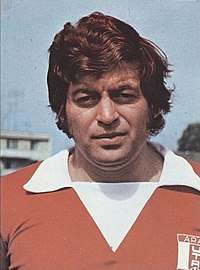
In 1965 Nicolae "Coco" Dumitrescu and Ioan Reinhardt were appointed as coaches, and at the end of 1965–66 edition, UTA finished the domestic competition on the 10th place, but qualified again in the final of the Romanian Cup, where, however, will lose with the score of 0-4 against the Steaua București. The team used in the final of the cup was: Carol Weichelt, Gavril Birău, Dumitru Chivu, Christos Metskas, Ioan Igna, Vasile Jac, Emil Floruţ, Nicolae Pantea, Flavius Domide, Mihai Ţîrlea, Mircea Axente, Ladislau Pecsovszky.
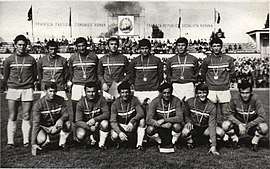
In the 1966–67 edition of the Divizia A, it occupied the 11th position. In the same period the club participated in the 5th edition of the Balkan Cup, being assigned in the 1st Series with Cherno More Varna, Partizani Tirana and Fenerbahçe. UTA had a modest run and only succeeded in one match out of six, a victory against Fenerbahçe in Arad, score 1-0.
In the 1967–68 edition it occupied the 4th place at the end of the season.
In the 1968–69 Divizia A season it became the champion of the country for the fifth time. The squad was: Gheorghe Gornea, Ion Bătrina, Gavril Birău, Bakos, Ştefan Czako, Mircea Axente, Jenő Pozsonyi, Petre Şchiopu, Mircea Petescu, Flavius Domide, Iosif Lereter, Ilie Moţ, Viorel Sima, Ladislau Brosovszky, Florian Dumitrescu, Brândescu, Atodiresei, Bodea
In the 1969–70 season, UTA won its sixth title and participated for the first time in the European Champion Clubs' Cup, but was defeated in the first round by Legia Warsaw (1-2 and 0-8).
In the 1970–71, the old lady took the 4th place and again participated in the European Champion Clubs' Cup, succeeding in eliminating the trophy holder at that time, Feyenoord[7] after a 1-1 at Rotterdam and 0-0 in Arad. The squad for the double against Feyenoord Rotterdam was: Gheorghe Gornea, Gavril Birău, Iosif Lereter, Mircea Axente, Jenö Pozsonyi, Mircea Petescu, Flavius Domide, Dumitru Calinin, Ladislau Brosovszky, Otto Dembrovski, Florian Dumitrescu. Reserves: Ion Bătrina, Petre Şchiopu, Viorel Sima, Ştefan Czako.
.jpg)
Before the match in the Netherlands, the players of Feyenoord Rotterdam, intercontinental champions at that time, were amused by the value and the look of the Arad team: They ironized us when they saw how we were dressed. They wanted to give us a new equipment from head to toe. Eventually, we played with boots, leggings and shorts from them, and our t-shirts, remembered Gavril Birău. But on the pitch the situation was different, because Florian Dumitrescu opened the score in the 14th minute: I centered, and he hit with his head, although he did not excel at the head shot. remembered Mircea Axente. Feyenoord then equalized by Jansen in the 25th minute and 1-1 remained to the end, with all the assault of the Dutch at the gate of Gornea and in the despair of the nearly 70,000 spectators. coach Nicolae "Coco" Dumitrescu described.[8]
Before the Arad second match, scheduled for 30 September 1970, exactly one year after the humiliation in Warsaw, Ernst Happel, the Austrian coach of Feyenoord said: A qualification of the Romanians at our expense would be equivalent to the eighth wonder of the world. The match ended 0-0, so UTA, supported by over 20,000 people, and, thanks to the goal scored in away, qualified further. After the game, UTA fans shouted at the coach of Feyenoord in front of Astoria Hotel: "Happel, Happel, Ha, Ha, Ha!"[9]
In the second round UTA was eliminated from the competition by Red Star Belgrade (0-3, 1-3).
In the 1971–72 edition the old lady became vice-champion of Romania and participated in the UEFA Cup, reaching the quarterfinals after overtaking Austria Salzburg (4-1, 1-3), Zagłębie Wałbrzych (1-1, 2-1) and Vitória Setúbal (3-0, 0-1). It was eliminated in the quarter-finals by Tottenham Hotspur (0-2, 1-1). This performance to reach the quarter-finals of the competition was the first Romanian spark in the UEFA Cup.
In the 1972–73 UTA took the 9th place in the Divizia A and participated for the second time in the UEFA Cup but was eliminated in the first round of the Swedish team IFK Norrköping.
In the following editions UTA occupied the following positions at the end of the championship: 1973–74 – 5th, 1974–75 – 8th, 1975–76 – 15th, 1976–77 – 12th and 1977–78 – 10th.
The decline and bankruptcy (1975–2013)
The decline started in the 1975–76 edition, materialized with a 17th place in the 1978–79 edition, thus UTA relegated for the first time in its history to Divizia B.
After two years in the second division (3rd place in 1979–80 and 9th in 1980–81), UTA returned to Divizia A under the technical leadership of coach Ştefan Czako, but failed to last for more than a year, relegating again to the second division after occupying only 17th place in Divizia A at the end of 1981–82 season.[10]

In the following two Divizia B seasons the team occupied the following positions: 2nd in 1982–83 and 5th in 1983–84, when, from the team coached by Gavril Birău and Flavius Domide were part the following players: Lovas, Bubela, Bodi, Gheorghieș, Gal, Hirmler, Gaie, Csodras, Ţîrlea, Váczi II, Vânăru, Găman, Tisza, Iliescu, Lupău, Roxin, Corec, Vuia, Cigan, Lalu, Leuc, Terez, Ţucudean, Negrău, Varşandan.
In the summer of 1984, UTA became a working football club, adopting the name of FCM (Workers Football Club) UT Arad.
Between 1984 and 1991, UTA occupieD the following positions in the 3rd Series of Divizia B: 13th in 1984–85, 4th in 1985–86, 10th in 1986–87, 3rd in 1987–88, 2nd in 1988–89, 2nd in 1989–90, 5th in 1990–91.[11]
And in the 2nd Series of Divizia B: 2nd in 1991–92 and 1st in 1992–93.[12]
After the promotion, the old lady managed to maintain only two years in the Divizia A, occupying the 11th place in the 1993–94 season and the 18th place in the 1994–95 edition, relegating again in the Divizia B.
Between 1995 and 2002, UTA occupied the following positions in the 2nd Series of Divizia B: 5th in 1995–96, 13th in 1996–97, 11th in 1997–98, 2nd in 1998–99, 6th in 1999–2000, 7th in 2000–01 and 1st in 2001–02.[13]
In the summer of 1999, UTA Arad disputed a play-off match at Alba Iulia against Rocar București for promotion in the Divizia A, a match lost 0 - 2. Coach Francis Tisza aligned the following team: Pap - Diaconescu, Botiş, G. Radu (50' Ciubăncan), Găman (76' Baciu), Panin - Todea, Almaşan, Zaha - Mariş, Cl.Drăgan (69' Turcan).[14]
In the 2002–03 edition of Divizia A, it is ranked 16th and relegated after only one year in the first league.
In the 2003–04 season, it occupied the 9th place of the 3rd Series of the Divizia B and in the 2004–05 season it took the 11th place at the end of the competition in the same series.
In the 2005–06 season, UTA finished 16th and relegated in Divizia C, for the first time in its history.
But UTA Arad will not play in this league because after an assignment agreement with Liberty Salonta, UTA would take the place of Liberty in Liga I and Liberty would take the place of UTA in Liga III.[15][16]
Thus, qualified in Liga I for the 2006–07 season, club president Nicolae Bara signed with coach Marius Lăcătuş and under his leadership, UTA occupied the 12th place at the end of the season.[17]
Marius Lăcătuş resigned on 1 October 2007 and at the end of the 2007–08 season, UTA, coached by Roland Nagy, owned by Nicolae Bara and Sandu Ion, occupied the 17th place and relegated again to the Liga II.
In the 2nd Series of the Liga II the white and reds occupied the following positions: 9th in 2008–09, 4th in 2009–10, 8th in 2010–11 (after a penalty of 12 points), 4th in 2011–12 and 4th in 2012–13.
In August 2013, Adrian Marțian, a controversial businessman, took over Giovanni Catanzariti's majority stake, promising the financial recovery of the club and to bring back the good results, but by November he lost the support of the supporters and the legend of the club, Flavius Domide, asking him to leave the club to competent people from Arad.[18][19]
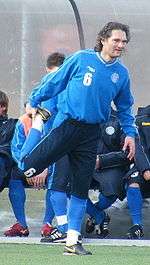
Another team, supported by a part of UTA fans, called UTA Bătrâna Doamnă was founded in 2013 by former player Marius Ţucudean, was enrolled in Liga IV instead of UTA II and receiving in March 2014 the logo, the record and the colors of UTA from UTA Supporter Club, the owner of these, becoming officially UTA Arad. The Liga II team had to change their name to FC UTA SA. At the end of the 2013–2014 season of Liga II, UTA SA was excluded from the championship by FRF for not attending two matches and relegated to the 6th League, where it did not sign up and therefore was dissolved.[20]
Rebirth (2013–present)
UTA Bătrâna Doamnă, promoted in the Liga III at the end of the season after a promotion play-off match against Hunedoara County champion Retezatul Hațeg, and won 2-0.[21]
After only one season in the Liga III the club promoted back to Liga II after finishing 1st in the 4th Series of the league, at 4 points ahead the second place, Nuova Mama Mia Becicherecu Mic.[22]
In their first season after the returning in the Liga II, UTA, now known as UTA Bătrâna Doamnă finished 2nd in the 2nd Series of the championship and qualified for a Liga I promotion play-off against Dunărea Călărași and Voluntari. The old lady eliminated Dunărea Călărași 5-4 on aggregate, but they lost 1-3 against Voluntari and remained for another season in Liga II.[23][24]
In the 2016–17 season, UTA finished 3rd, now in a one group of 20 teams, and qualified again for a promotion play-off, this time against Poli Timișoara, one of Politehnica Timișoara successors, together with ASU Politehnica Timișoara, but they lost again the chance to return in the first league, now after a double defeat (1-2, 1-3).[25]
In the summer of 2017, FRF has officialized that UTA Bătrâna Doamnă changed his name back to FC UTA Arad being the official and legal successor of the old club.[26]
Grounds
.jpg)
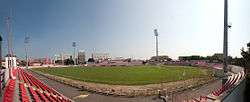
The club plays its home matches on Stadionul Motorul in Arad, because their stadium, Stadionul Francisc von Neuman, is under reconstruction. Because the reconstruction of Stadionul Francisc von Neuman is not ready until 2018 the club decided to modernize Motorul Stadium so the club can play home if they promote, until then the team will play at Otto Greffner. After one year and a half spent at Otto Greffner the team will return to play at Motorul Stadium which is newly renovated until the construction of the new Stadionul Francisc von Neuman is finished.
Support


UTA also have a large collective of supporters named Ultras Arad. The only active ultras group of this collective is called Out of Control. Former groups: Red Fighters(1996-2006), Spetza Ultra Rossa(2003-2011), Directivo Ultra', Commando Hooligans, RASA, Red Skorpions, Rebel Yell, Rascals. After Spetza Ultra Rossa quit, all the remaining groups united into one single group named Arad 1945 which lasted from 2012 to 2016. Their main rivalry is with the supporters of Poli Timișoara, but also with FC Rapid București and FC Universitatea Cluj. They have a friendship with fans of Corvinul Hunedoara (currently supporting FC Hunedoara)[27] and ultras of CSA Steaua București.
Rivalries
UTA's most important rivalry is with Politehnica Timișoara. The match between them, Derbiul Vestului (West Derby), has been the leading Romanian football encounter in the last 65 years, as UTA and Poli are the two most successful football teams from the west of the country.
Honours
Domestic
Leagues
Cups
- Cupa României
- Cupa României – Arad County Phase
- Winners (1): 2013–14
- Cupa Ligii
- Runners-up (1): 1994
European
- UEFA Champions League / European Cup
- Best result: Second round 1970–71
- UEFA Europa League / UEFA Cup
- Best result: Quarter-finals 1971–72
- Balkans Cup
- Best result: Group stage 1966–67
European record
| Competition | S | P | W | D | L | GF | GA | GD |
|---|---|---|---|---|---|---|---|---|
| Balkans Cup | 1 | 6 | 1 | 0 | 5 | 4 | 12 | – 8 |
| UEFA Champions League / European Cup | 2 | 6 | 0 | 2 | 4 | 3 | 17 | – 14 |
| UEFA Europa League / UEFA Cup | 2 | 10 | 3 | 2 | 5 | 13 | 14 | – 1 |
| Total | 5 | 22 | 4 | 4 | 14 | 20 | 43 | – 23 |
Players
First team squad
- As of 2 October 2018
Note: Flags indicate national team as defined under FIFA eligibility rules. Players may hold more than one non-FIFA nationality.
|
| ||||||||||||||||||||||||||||||||||||||||||||||||||||||||||||||||||||||||||||||||||||||||||||||||||||||||||||||||||||||||||||||||||||||
Out on loan
Note: Flags indicate national team as defined under FIFA eligibility rules. Players may hold more than one non-FIFA nationality.
|
|
Second team squad (UTA II)
- As of 4 September 2018
Note: Flags indicate national team as defined under FIFA eligibility rules. Players may hold more than one non-FIFA nationality.
|
| ||||||||||||||||||||||||||||||||||||||||||||||||||||||||||||||||||||||||||||||||||||||||||||||||||||||||||||||||||||||||||||||||||||||||||||||||||||||||||||||
Club officials
Board of directors
|
Current technical staff
|
Notable former players
The footballers enlisted below have had international cap(s) for their respective countries at junior and/or senior level. Players whose name is listed in bold represented their countries at junior and/or senior level on through the time's passing. Additionally, these players have also had a significant number of caps and goals accumulated throughout a certain number of seasons for the club itself as well.
|
|
|
Famous managers
|
|
Season by season
|
|
References
- ↑ "Despre noi" [About us]. FC UTA Arad (in Romanian).
- ↑ "Membrii cu drept de vot în SCU, inclusiv Bara, au decis: drepturile federative trec la UTA Bătrâna Doamnă care va deveni UTA Arad!" [Members with voting rights in SCU, including Bara, decided: federative rights are passed to UTA Bătrâna Doamnă, which will become UTA Arad!]. Sport Arad (in Romanian). 16 March 2014. Archived from the original on 2016-03-17.
- ↑ UTA, sponsorizat de o Universitate! Vezi povestea clubului infiintat de baronul Neumann!. sport.ro
- ↑ Bicicleta baronului Neuman. historia.ro
- ↑ Stadionul „Francisc Neumann”- micul Highbury de Arad. adevarul.ro
- ↑ Există un record pe care Steaua nici nu visează să îl depăşească în acest sezon. libertatea.ro
- ↑ UTA - Feyenoord, o victorie de legendă. Florian Dumitrescu: "De frică ne-am mobilizat total". evz.ro
- ↑ UTA … o legenda. araduta.wordpress.com
- ↑ UTA … o legenda. araduta.wordpress.com
- ↑ Divizia B - Istorie. romaniansoccer.ro
- ↑ Divizia B - Istorie. romaniansoccer.ro
- ↑ Divizia B - Istorie. romaniansoccer.ro
- ↑ Divizia B - Istorie. romaniansoccer.ro
- ↑ Barajul Rocar - UTA, la Alba Iulia. ziaruldeiasi.ro
- ↑ In fotbal, ca la piata: UTA si-a cumparat locul in Liga I. newspad.ro
- ↑ UTA este în Divizia A . aradon.ro
- ↑ Dinita, Drida si cinci stelisti, doriti de Lacatus la UTA. romanialibera.ro
- ↑ Adrian Martian va deveni oficial actionar majoritar la UTA. romaniansoccer.ro
- ↑ Fotbal / Afaceristul clujean Adrian Marţian nu mai este dorit la UTA. transilvaniareporter.ro
- ↑ E oficial! FC UTA, exclusa din campionat. aradon.ro
- ↑ UTA BD a promovat in Liga III. aradon.ro
- ↑ Dat afară de la UTA, Voicu a sărbătorit în lacrimi promovarea echipei arădene | VIDEO. Suporterii îl vor înapoi: ”Deja şi-a ispăşit pedeapsa”. liga2.prosport.ro
- ↑ MIRACULOS. UTA - Dunărea Călăraşi 4-1. Arădenii câştigă un meci epuizant, cu gol în repriza de prelungiri şi cu un om mai puţin pe teren. Fanii au invadat terenul după fluierul final. liga2.prosport.ro
- ↑ UTA Bătrâna Doamnă - FC Voluntari 1-0. Ciprian Rus a adus victoria arădenilor, însă Voluntariul a rămas în Liga 1. digisport.ro
- ↑ UTA - ACS Poli 1-3. Timişoara a câştigat şi returul barajului şi rămâne în Liga 1. digisport.ro
- ↑ UTA Bătrâna Doamnă redevine UTA Arad. dincolodesport.eu
- ↑ http://www.ultras-tifo.net/photo-news/3000-corvinul-uta-arad-22-11-2014.html
- ↑ "UTA Arad" (in Romanian). uta-arad.ro. 2015-08-01. Archived from the original on 2015-12-08. Retrieved 2015-08-01.
- ↑ "UTA Arad" (in Romanian). liga2.prosport.ro. 2017-06-30. Retrieved 2017-07-01.